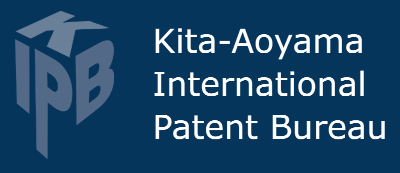Utility Models Q&A
A patent provides monopoly rights to make, use and sell an invention, but it is not the only way to protect an invention. Utility models are another type of monopoly right for inventions in Japan and many other countries, that can prove cost-effective in securing an enforceable right quickly.
Check out our overview of utility models in Japan, if you are interested in pursuing this type of right for your invention. If you don't find the answer you need here, please contact us and we'll be happy to provide further information and advice.
- Utilize recognised laws of nature. That is, not imply the laws themselves or be intellectual activities or methods, etc.
- Be a technical idea. That is, (a) addresses a technical problem, (b) provides a technical means for solving the problem, (c) explains the technical operation and effect, and allows replication and enablement by skilled persons in the relevant art.
- Be a creation. That is, not the mere discovery of a natural law, etc. that already existed, but active creation through intellectual endeavour.
- Within one month from the filing date, or
- During the time specified for a response to an amendment order by the JPO.
What is a utility model?
A utility model is a category of intellectual property that is similar to a patent, but does not require the same level of invention, and can be registered more quickly, cheaply and easily. The trade-off is that the subject of protection is more limited, the term of protection shorter (in Japan – 10 years vs. 20 years for a patent), and enforcement generally more difficult.
What is the scope of utility model protection?
According to the Japanese Utility Model Act, the subject matter of utility model protection is limited to "devices" related to the spatial shape or structure of an article or combination of articles. Utility models must also be "the creation of a technical idea utilizing the laws of nature" (Art. 2(1)). That is, they must:
In contrast, Japanese patents protect "inventions" involving highly advanced technical ideas – "invention" and "device" denoting the level of technical creativity and ideas required.
Since utility models only protect the shape and structure of "devices", materials such as pharmaceutical products and chemical compounds, methods and manufacturing processes, and software are not within the scope of protection. A patent is required for these inventions.
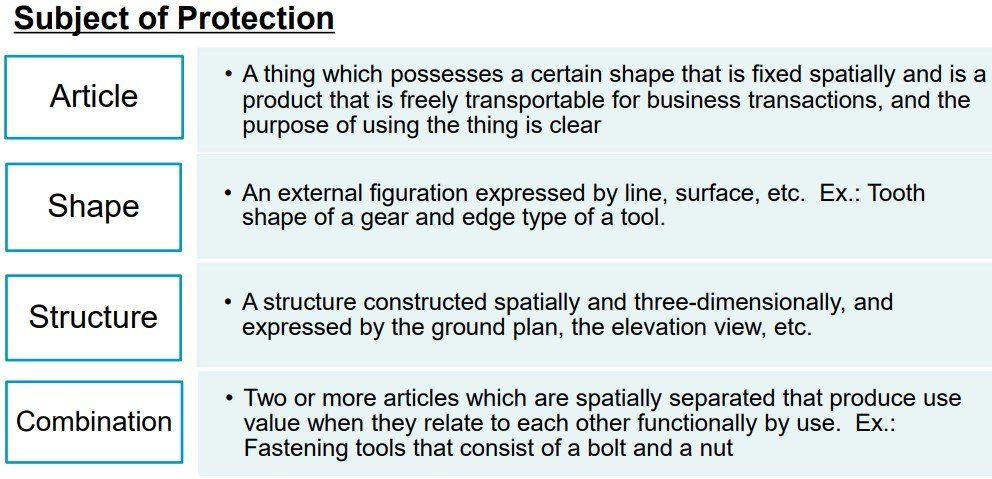
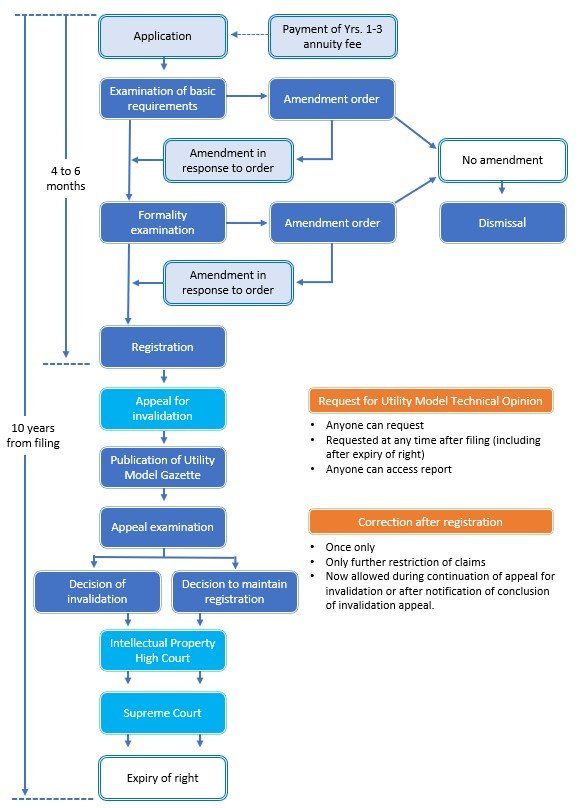
Utility models provide low cost and rapid IP protection. However, compared to patents, protection is limited in duration and scope, and enforcement of rights is more difficult. These pros and cons mainly derive from the lack of substantive examination during the prosecution (see "Examination" section below). The utility model holder needs to be fairly circumspect in bringing infringement cases against competitors, and can only do so by first requesting a technical opinion from the JPO on substantive requirements (see "Utility Model Technical Opinion" below). They also need to be vigilant against third party invalidation requests that may lead to damages.
Utility model protection is worth pursuing if an applicant judges that their product ("device") is likely to be short-lived or is maybe not valuable enough to justify the time and financial outlay needed for obtaining a patent. Registering a utility model is also an effective way of disclosing an invention quickly, for the purpose of discouraging rivals from marketing similar products or copies.
Furthermore, since utility model applications can be converted into patent applications up to 3 years after filing, a reasonable strategy for an applicant might be to first file a cheaper utility model application and then convert to a patent application that offers better protection, if the invention proves to be commercially successful.
We at KIPB believe utility models are therefore particularly useful to start-ups and SMEs, that need to attract capital investors and show results quickly.
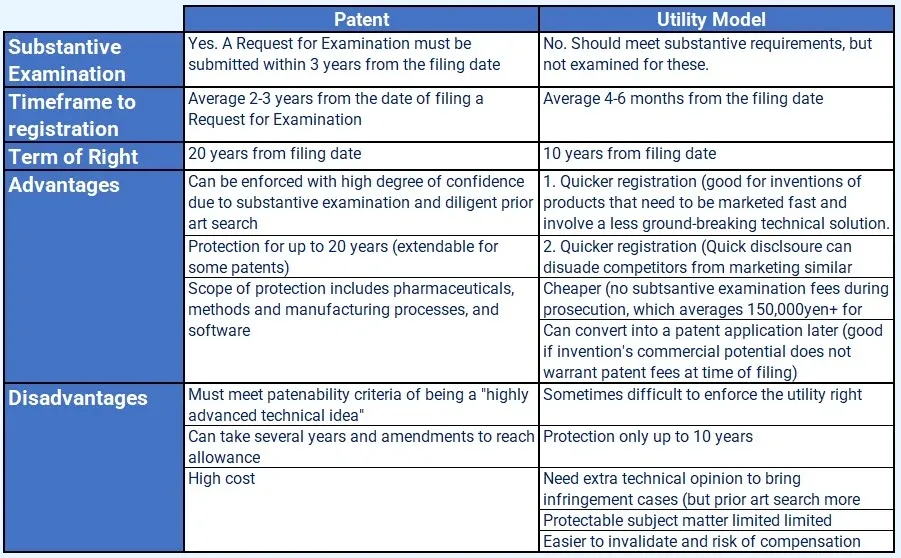
What are actual examples of utility models in Japan?
Examples of utility model "devices" in Japan have included a fastener composed of a bolt and a nut, an attachable PET bottle cap, a collapsible tissue box and a multi-directional floor wiper.
Nissin Cup Noodle
A famous example of a Japanese utility model is that which became Nissin Cup Noodle – the instant-ramen-in-a-cup that has sold more than 50 billion units worldwide.
Nissin's utility model described that the conical trapezoidal-shaped dried noodle block matches the shape of the cup (inclined from the bottom) so that the noodle block sits securely between the upper and lower space of the cup. This: (a) provides strength to the cup and secures the noodles, so that (i) the noodles are not damaged in transit and (ii) the dried vegetable ingredients on top do not fall down the sides of the noodle block; and (b) provides a cavity at the bottom of the cup to allow heat convection. The combined shape and structure/positing of the various articles allows the noodle block to be restored quickly and evenly cooked when hot water is poured on. ("Snack noodles in a cup that restores to a cooked state when hot water is added" - Japanese Utility Model No. 1428858 (Japanese Examined Utility Model Publication No. S55-043994 – filed March 25, 1971.)
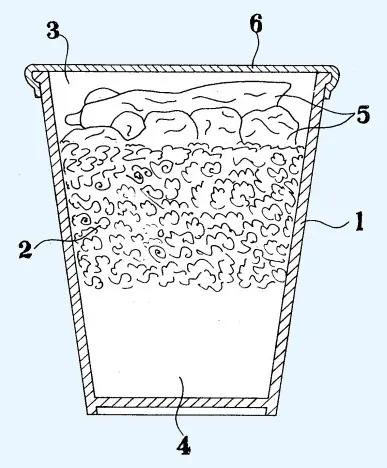
KEY: 1. Heat-insulating cup; 2. Easy-to-rehydrate, hot-oil-processed noodle block; 3. Upper space; 4. Lower space; 5. Dried ingredients; 6. Lid.
Nissin also filed a patent application at the same time which dealt with the actual process of producing the instant noodles that could sit in a dried block in a container in a way (i.e. compacted at the top and sparse at the bottom) that could easily and informally be restored to a cooked state by adding hot water. (Method of manufacturing snack noodles with a container, Japanese Patent No. 0924284)
How do I apply for a utility model in Japan?
A utility model application should include a description, claims, drawings and abstract.
Drawings are obligatory since the subject of protection relates to the shape of articles as mentioned above. We are required to submit all original claims of the original application.
PCT Route
For PCT applications entering the Japan national phase, the deadline for entry is 30 months from the priority date of the original national or regional application (or International filing date of the PCT application if no priority claimed).
For PCT applications filed in a foreign language, a Japanese translation of the application must be submitted (i) within 30 months from the priority date, or (ii) 2 months from the national phase entry date, whichever comes later.
Paris Route
For Paris route applications, utility models should be filed within 12 months of the filing date of their priority application. Unlike Paris route patent applications, Paris route utility model applications must be submitted in Japanese.
What are the official fees for filing a utility model?
The current JPO fees are the same for PCT or Paris route utility models. Unlike patent applications, the first 3 years of annuity fees must be paid at filing along with the basic filing fee.
Filing fee: JPY14,000-
Annuities Yrs1-3*: Total = 6300yen + 300 yen per claim
*Required at filing.
Does Japan have a grace period for utility models disclosed before filing a utility model application?
Yes.
Overview – what is a novelty grace period?
In principle, only utility models that have not been disclosed to the public before the filing date can be registered as utility models. Public disclosure can include published experiments, presentations, media broadcasts and publications, on the internet, at trade fairs, in sales, etc. If a utility model has already been so disclosed, the examiner will issue lack of novelty or inventive step rejections.
However, like the US, Japan has a "grace period" (or "Exceptions to Lack of Novelty") according to which the already disclosed utility model is not considered prior art. This grace period is available for a first public disclosure within one year before the filing date. In other words, utility model applications should be filed within one year from the date of first disclosure. The one-year rule applies to applications filed on or after 9 June 2018 with disclosures made on or after 9 December 2017 (the grace period was 6 months prior to these dates).
Note that the grace period can only be sought by the persons having the right to the utility model, and must be actively sought if the public disclosure was made by themselves. (This is not obligatory if the disclosure was made against the will of the right holder, in which case a grace period can be asserted in an argument against an office action, for example.)
Eligible public disclosures are limited to non- IP applications and registrations such as the examples mentioned above (made by the patent holder or against his/her will).
Process & Eligibility
(i) PCT applications entering the Japan national phase.
The filing date in Japan is defined as the international PCT filing date. Thus, to be eligible for the grace period, the PCT application should (i) be filed at the international stage within one year of the first disclosure, (ii) designate Japan (iii) include a grace period request. The grace period can then be asserted at filing in Japan and a statement/certificate of proof can then be submitted to the JPO within 30 days of national phase entry, or 2-month period for translation thereafter (whether (iii) was done or not).
(ii) Paris Route applications
For Paris route applications filed directly into Japan, the first disclosure should be within one year prior to the filing date of the Japanese application. The grace period request should be submitted at the same time as filing, and the statement/certificate of proof within 30 days of filing (with possible extensions).
Due to ongoing difficulties due to the global pandemic, the JPO no longer requires signatures (original or electronic) on these supporting documents for the request (AT TIME OF WRITING).
Note:
Unlike the US, the grace period in Japan does not provide protection against third-party disclosures made after the disclosure (by or against the will of the right holder) for which the grace period is activated.
Please contact KIPB Japan, if you have a particular question concerning your utility model application and/or the possibility of requesting a grace period.
Are there any restrictions on the number of claims?
There are no general restrictions on the number of claims at the time of writing. Note also that claim fees at the time of filing are based on a simple calculation of the total number of claims (see fees above).
Are there any restrictions on claim dependency?
Multiple dependent claims depending on other multiple dependent claims are not permitted (this rule applies to applications filed on or after April 1, 2022).
The JPO defines a multi-multi claim as 'a claim that selectively cites two or more other claims that also selectively cite back to two or more other claims.'
To illustrate, please see the following example set of claims:
Claim 1 A device with A.
Claim 2 A device as claimed in claim 1 further comprising B.
Claim 3 A device as claimed in claim 1 or 2, further comprising C.
Claim 4 A device as claimed in any one of claims 1 to 3, further comprising D.
Claim 5 A device as claimed in any one of claims 1 to 4, further comprising E.
Here, claim 3 is a multiple dependent claim only, so allowed.
However, claims 4 and 5 are multiple dependent claims depending on other multiple dependent claim(s), and not allowed.
An order to amend will be issued for applications containing such claims, as they do not meet the basic requirements for utility models (See Amendments below.)
What is the duration of a utility model right?
10 years from the date of filing. By comparison, patent rights are 20 years from the filing date.
Can I convert a patent application into a utility model application?
Yes, a patent application may be converted to a utility model application and vice versa.
Converting from patent to utility model:
--- Not possible for patents already converted from a utility model registration.
--- Must be within 3 months of a decision of rejection and within 9 years and 6 months from the patent application filing date
Converting from a utility model to patent application:
--- Must be within 3 years of the utility model filing date.
--- Must abandon utility model to avoid double patenting.
Is it possible to apply for a Japanese utility model based upon a Paris convention application or a PCT international application entering the Japan national phase?
Yes. Applicants can choose between a patent application or utility model at filing in Japan.
Is it possible to apply for a Japanese utility model AND a Japanese patent, based upon a Paris convention application or international PCT application entering the Japan national phase?
No, applicants cannot file both a utility model AND a patent based on the same application. You can only choose one.
However, since it is possible to convert a patent application into a utility model application (and visa versa) after filing, it is technically possible to file a convention application or national stage entry application initially, and subsequently file a divisional application (converting this to a utility model), and have the two run concurrently.
Note that the claims for the utility model would need to be different to the patent application (i) to avoid double patenting, and (ii) since the scope of utility model protection is limited to technical ideas relating to the shape or structure of an article or combination of articles ("methods" and "software" claims are not acceptable. See above.)
Is it possible to file a PCT international application based on a Japanese utility model application?
Yes. A PCT international application may be filed based on a Japanese utility model application (with the JPO acting as the WIPO Receiving Office) within one year of the utility model filing date.
If Japan is self-designated in the PCT application, it is not necessary to request conversion of the utility model into a patent application when entering the national phase in Japan.
However, the original Japanese utility model must be abandoned when the Japanese patent is granted through the PCT route.
Is it possible to obtain a patent right AND a utility model right for the same invention?
No, double registration is not possible for the same invention. If the patent application and utility model have been filed on different dates, the earlier application is subject to grant and the other deemed withdrawn. If the filing date is the same, then one or the other must be chosen, not both.
Can I file a divisional application?
Yes, applicants may file divisional applications during the period when amendments are possible.
That is:
(See 'Amendments' below.)
When is a utility model published?
Unlike patents, utility models are only published (meaning open for third parties to view) after registration. At this point, third parties can see the content of the registration and file an invalidation if they wish.
Are utility models examined like patents?
Although utility models must meet the same substantive requirements as patents (such as novelty and inventive step), rights are granted without these requirements being examined. This reflects the narrower scope and shorter-term of rights compared to patents.
Examination of basic requirements and formality requirements
Utility model examination is instead limited to checking whether the application meets basic requirements and formality requirements*. This includes confirming that: (1) the subject of protection is a “device” related to the shape or structure of an article or combination of articles (i.e., not a method, substance etc); (2) the device does not violate public order or morality; (3) the application meets the requirements for the format of claims as well as the unity of application.
However, once a utility model is registered any third party can file an invalidation trial on the basis of substantive requirements, at which point the JPO will examine the registration for these requirements.
No examination fees
Since there is no examination based on substantive requirements (novelty, inventive step, etc), no examination fees are incurred. Note that official examination fees for patents average at least 150,000 to 200,000 yen, so this represents a significant saving.
* A right holder (or any interested person) can also request a “Report of Utility Model Technical Opinion” from the JPO to verify substantive requirements (see “Utility Model Technical Opinion” section).
Can I make voluntary amendments?
Yes, but only within one month from the filing date (Utility Model Act, Art. 2-2; and Cabinet Order on Utility Model, Article 1). The amendment must also be within the scope of the original specification.
Amendments in response to an amendment order
Amendments can also be made during basic requirement and formality examinations if required by the examiner (only for the purpose of conforming to these requirements). If no amendments are made in response to these demands or amendments continue to fail to bring the application into the scope of formality or basic requirements, the application will be dismissed.
Timeframe:
--- Amendments in response to demand during Basic Requirement Examination – Within 3 months (extendable by 3 months)
--- Amendments in response to demand during Formality Examination – Within 30 days.
There is a further limited opportunity to "correct" claims after registration. See "Correction" section below.
How long does it take to register a utility model?
In our experience, this only takes about 4 to 6 months from filing to registration.
Utility models are granted and published after the basic requirements and formality examinations (including opportunities for conformity amendments) have been cleared. Registration is then a formality since the first 3 years of annuity fees (which also serve as registration fees) have already been paid at filing.
What is a Report of Utility Model Technical Opinion?
This is an assessment of a utility model based on the result of a prior art search that is undertaken by a JPO Examiner. It will contain their expert opinion on substantive requirements such as novelty and inventive step for each claim.
Why is this necessary?
Since a utility model is registered without substantive examination, its validity in terms of the relevant substantive requirements often remains uncertain at registration. Thus, to avoid potential abuse of a utility model right (due to the possibility that that utility model actually contains grounds of invalidation), a right holder may not exercise their right against an infringer until they verify their utility model fulfils the substantive requirements.
They can do this by requesting the Utility Model technical opinion from the JPO. Once issued, a utility model rights holder can exercise their right after presenting the report to a suspected infringer, warning them off continuing with the potential infringement.
It is important to note that there is no guarantee the utility model technical opinion will be favourable. The examiner may deny substantive requirements are met.
It is also important to note is that any person may make a request for a technical opinion after a utility model is filed, not just the applicant. Third parties may do so if they suspect potential invalidation, for example.
What remedies are there if the examiner issues an unfavourable technical opinion against my utility model?
No appeal is available to a utility model applicant or right holder against an unfavourable technical opinion report. However, applicants can correct claims within 2 months from the issuance of the technical opinion (as long as it is the first technical opinion and claims have not been previously corrected.) An applicant can also cancel claims that have been unfavourably assessed. See "Correction" section below.
When can I exercise my utility model right against third parties?
You must first present them with a warning letter and the Report of Utility model technical opinion mentioned above.
Risks of bringing infringement actions
If the JPO judges that the infringement action is invalid (possibly even judging the utility model should be cancelled), the utility model owner is liable for any damages caused to the other party in respect to the warning letter and infringement action. However, utility rights holders may be exempted from liability for damages if they exercised utility model rights and/or sent warnings to possible infringers on the basis of a positive technical opinion from the JPO.
The onus is also on the utility right owner, not the infringer, to prove the validity of the infringement action. They should not simply rely on a positive Utility Model Technical Opinion from the JPO to establish substantive requirements since the scope of the prior art search on which they are based tends to be more limited than for a patent prior art search (and commonly omits foreign language publications).
Can I correct claims?
Yes, but you are given only one opportunity to do so, and the scope is limited.
You can correct (once) at any time, apart from (i) after 2 months from the issuance of a (usually negative) utility model technical opinion or (ii) after the designated response time in an invalidation trial.
Corrections are limited to restricting claims, correction of errors, clarification of descriptions, or converting dependent claims to independent claims.
Claims can also be cancelled at any time, apart from during challenges to the utility model or after the conclusion of invalidation trials.
